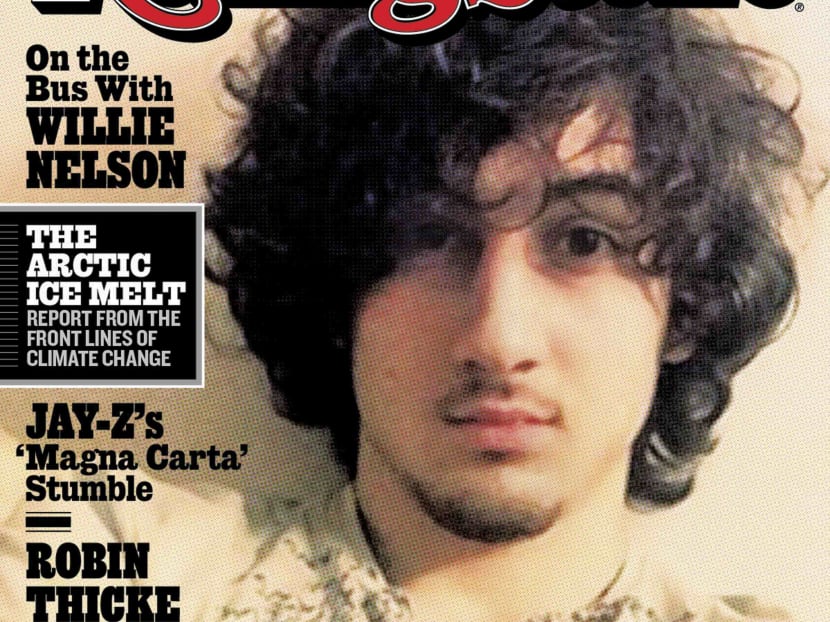Rolling Stone’s Boston bombing suspect cover ignites heated debate
NEW YORK — With his smoky eyes and tousled hair, the subject of the latest Rolling Stone cover story could pass for any rising United States music star.

Accused Boston bomber Dzhokhar Tsarnaev is seen on the cover of the August 1 issue of Rolling Stone magazine in this handout image received by Reuters July 17, 2013. Photo: Reuters
NEW YORK — With his smoky eyes and tousled hair, the subject of the latest Rolling Stone cover story could pass for any rising United States music star.
But this is no ordinary pop portrait. The stark cover line, “The Bomber”, overlays a picture of Dzhokhar Tsarnaev, the 19-year-old Boston Marathon bombing suspect, and when the magazine published the cover on Tuesday night there was an immediate backlash. One criminologist warned that it glorified Tsarnaev — accused of planting bombs which killed three people and injured more than 260 others — and could send a dangerous message to others. Yesterday (July 17), the US pharmacy chain CVS said it would not stock the issue.
The photo accompanies an article by Rolling Stone contributing editor Janet Reitman, which the magazine described in a pre-publicity notice as a “deeply reported account” of Tsarnaev’s life, including the revelation that he had played down his Muslim faith in high school. The magazine promised “a riveting and heartbreaking account of how a charming kid with a bright future became a monster”. It later posted the full article, along with a defence of the piece, saying it fell within the magazine’s tradition of reporting serious political and cultural issues.
The Tsarnaev cover drew considerable attention on the magazine’s Facebook page, with 9,000 comments posted by yesterday morning.
Rolling Stone did not immediately publish the Tsarnaev profile online, which had the effect of focusing the initial debate on the picture.
On Facebook, reader Shawn Anthony wrote: “I think it’s wrong to make celebrities out of these people. Why give the guy the cover of Rolling Stone?” in a sentiment that was given the thumbs up by 1,202 people.
“Jeff Bauman, who lost both legs, should be on cover,” wrote another reader, Mr J Harper Philbin, in a post liked 1,428 times.
“I am ending my subscription. This is bullshit. Let’s honor those who hurt innocent people. Who’s next, George Zimmerman?? Rolling Stone is a music magazine, not the Taliban Times,” wrote another Facebook user.
Northeastern University criminologist Jack Levin told MyFoxBoston.com that the cover could send a dangerous message to others who might be minded to carry out violence: “If they want to become famous, kill somebody.”
Within hours, CVS announced that it would not sell the issue in its store. “As a company with deep roots in New England and a strong presence in Boston, we believe this is the right decision out of respect for the victims of the attack and their loved ones,” it said.
Mr Dan Kennedy, who teaches journalism at Boston’s Northeastern University, said he shared Mr Levin’s concern, but said that “purely as a magazine cover, it was kind of brilliant”.
“It works because of cognitive dissonance. We see him looking rather angelic on the cover, and just about every picture we’ve seen of him he looks angelic, that apparently is how he looked,” he told the Guardian.
“And meanwhile we see the cover type: ‘The bomber. A monster’. So that works well as a really dissonant juxtaposition.”
Mr Kennedy noted that no retailers refused to carry the New York Times when it used the same picture on its front pages, and said the furore may have been driven by a lack of understanding of the kind of journalism Rolling Stone does.
“I assume that the editors at Rolling Stone knew that the cover would be controversial, but this may be spinning out of control in ways they did not anticipate.
“One possible explanation for that is that a lot of people really don’t understand Rolling Stone. They think it features nothing on the cover but entertainers and celebrities, and in fact Rolling Stone often features serious news on the cover.”
Last week, Tsarnaev pleaded not guilty to 30 counts, including use of a weapon of mass destruction to kill, a charge that could result in the death penalty. Federal prosecutors allege that Tsarnaev and his brother, Tamerlan Tsarnaev, planted improvised bombs made from pressure cookers close to the finishing line of the Boston marathon on 15 April.
Three people were killed and 264 injured in the blasts. Three days later a police officer was killed during a gunfight between the Tsarnaevs and police. Tamerlan Tsarnaev also died during the standoff, and Dzohkar Tsarnaev was found the next day, hiding in a boat.
Rolling Stone issued a statement defending its cover story yesterday. It read, in full:
“Our hearts go out to the victims of the Boston Marathon bombing, and our thoughts are always with them and their families. The cover story we are publishing this week falls within the traditions of journalism and Rolling Stone’s long-standing commitment to serious and thoughtful coverage of the most important political and cultural issues of our day. The fact that Dzhokhar Tsarnaev is young, and in the same age group as many of our readers, makes it all the more important for us to examine the complexities of this issue and gain a more complete understanding of how a tragedy like this happens.” THE GUARDIAN






